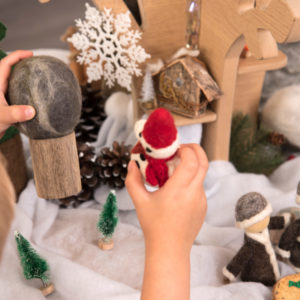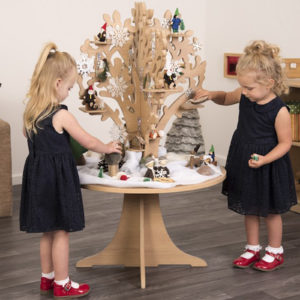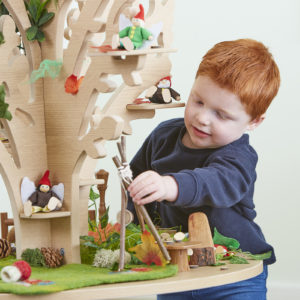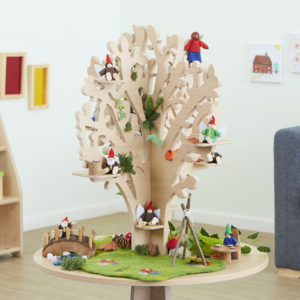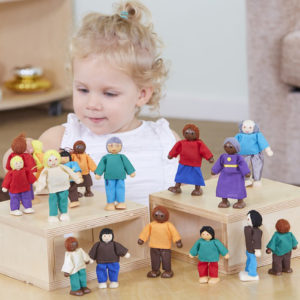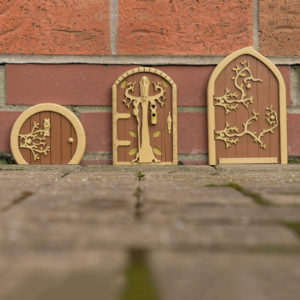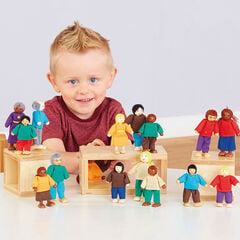Children love to engage with miniature characters and create all kinds of imaginative worlds. This sparks their imaginations, creativity and engages their interests. It equally provides many valuable learning opportunities, particularly surrounding the development of language.
From tiny secret messages behind mysterious magical doors to the designing of your very own mystical castles and enchanted worlds, we have put together 5 of our favourite ideas for learning with miniature characters.
1. A faraway fairytale world
Children are intrigued by fairy tales and love to take part in imaginative scenarios. The particular focus on fairytales opens up opportunities for bringing in new descriptive and imaginative vocabulary.
Space:
A natural outdoor environment would be perfect for this activity. Maybe at the bottom of a tree or amongst a flower bed? Indoors is also an option, ideally somewhere that can be easily cleaned, such as waterproof surfaces to allow for natural materials to be used inside.
Materials:
Fairytale characters, or any other characters that you might be able to dress as fairies or other magical creatures – you can even make your own! Natural materials such as pieces of wood, leaves, moss, stones, pinecones. This will add a real woodland theme, particularly if you are indoors.
Activity:
Create a mystical fairytale world together with wonderful wizards, faraway kingdoms and enchanting elves. Make a landscape together using the natural materials that you can find around you. You might want to give yourselves two separate locations and create entirely different fairytale worlds from your own imaginations and share this once you have finished your creations.
Learning opportunities:
- Encourage children to think of the best suitable location for their fairytale world
- Go on a hunt for the materials you might need e.g. natural materials
- You might make your own fairytale creatures out of things you find around your home or garden
- Share your fantasy worlds with each other when you have finished creating them. You might do this through telling a story or in a scenario where one of your characters visits the other fantasy world and receives a tour!
- You can create furniture, transportation or animals to go in your fantasy world
Areas of learning supported:
This activity will certainly support imaginations to flourish. Allow children the time and space to be creative. They might choose to use a large amount of space or even a very small space. Make sure you have collected plenty of extra materials, to allow for imaginatively recreating their purposes. Arts and crafts skills will come to life as you design and create your worlds. Create the interior too, such as thrones, bridges, castles, caves and mini accessories.
Storytelling and listening skills can be developed as you both describe your fantasy worlds to each other by creating a story. This involves communication and language as you bring your imaginations into words. Model using rich descriptive language, such as ‘gigantic, evergreen, prickly trees’. Children will pick up on new words and either ask you what these mean or begin to understand them as you use these new words in context. You can extend this further into literacy by having a go at writing your stories together. Younger children might have a go at labelling parts of their enchanted worlds.
2. Creating mini homes
Space:
Anywhere suitable for an arts and crafts type activity. You might want to use a large table but a floor space can be even better as children will have more space to spread out. You can place a plastic or an old washable cotton sheet on the floor to contain any mess.
Materials:
You can use recyclable materials such as large or small cardboard boxes or card. Connecting materials such as glue, cellotape or string. Decoration materials such as paint, paper and other arts and crafts materials. You might also want to use clay, old tyres or even old welly boots!
Activity:
Get creative together by designing and creating your very own mini homes for your characters, using materials you might find at home or in the garden. This is a great opportunity to do some upcycling!
Learning opportunities:
- Make creative use of clean recyclable materials (ensuring these are safe to use)
- You can use clay to mould and create small houses, caves or gardens for your characters
- Think about what your characters might need in their homes? Can you kit it out with thrones, tables and beds?
- Have a go at upcycling some things you might find around the house or garden, including old welly boots or tyres! It might be hard to believe but with a little bit of creativity these can be made into incredible fairy homes!
Areas of learning supported:
Fine motor skills will be supported as part of children’s physical development. These are the small muscle movements children use as they manipulate small materials whilst creating and joining pieces together.
Problem solving skills will be developed as children think about and try to connect pieces of material together, overcome any difficulties and think of new ideas. Children will be experiencing trial and error and changing strategies when they experience difficulties, encourage children to do this by persevering.
Using recyclable materials and upcycling provides the perfect opportunity to speak to children around sustainability and how they can contribute to the care for the world in which they live in.
3. Creating profiles for your characters:
Space
A comfortable space for writing and drawing, this doesn’t need to be at a table, younger children benefit from spreading out and working in a different space. An outdoor space can provide children with more inspiration and a change of scenery for their writing.
Materials
Paper and pencils. Any additional arts and crafts materials for decoration at the end.
Activity
Get imaginative and create your very own characters and their profiles. You can do this through drawing, writing and incorporating arts and crafts. You can even do this digitally if you would like to support your child’s use of technology for a purpose. This would be implementing basic digital design skills at an early age.
Learning opportunities
- Whilst creating your profiles, you can have conversations about what you are doing. Ask your child questions to provoke thinking, for example, does your character need to go to work? What do they do? How do they get around? What is their personality? What are their skills? Who is in their family?
- This is also a nice activity to be working on independently yet side by side, you can have conversations about many other things whilst both engaging in a creative activity.
- Consider presenting your characters to each other or other members of your family. You can even do this through online communication for family members and friends outside of your household, videoing would work particularly well.
Areas of learning supported
Children’s literacy will be supported here as they engage in communicating meaning through different ways, whether this is through writing, drawing and even more creative ways such as crafts.
Children will also be reading, whether this is reading the meaning of a drawing or the meaning behind a creative piece of craft. You can facilitate children to read phonetically by labelling your drawings and writing a sentence to describe your character. Make sure this is written clearly and simply to allow children to have a go at recognising the letters and sounding them out.
Communication is key to this activity as it allows for the flow of ideas between you. You can spark thoughtful discussions or ideas. You can even use this opportunity as a quiet and engaging activity through which to chat about your day or other topics.
Encourage creativity and imagination by providing a range of materials to use, such as crafts or recyclable materials. If you are drawing or writing, encourage creativity by asking open-ended questions.
Presenting their characters and character profiles will allow children to not only develop their communication skills but equally their confidence. Ensure you use plenty of encouragement and praise, you can also model presenting first to put children at ease and give them an understanding of what a presentation might look like.
Incorporating technology into this activity can be a valuable opportunity. Either through creating your characters and their profiles digitally or presenting this digitally. This will allow children to understand how technology can be used for a purpose, in this instance it would be for creative design, communication and presentation. These are all vital skills for their future.
4. Hide and seek:
Children love to hide objects and play hide and seek. This activity has the opportunity for learning many things together and developing new skills, such as the concept of a key on a map.
Space
Indoors or outdoors.
Materials
A number of characters to hide, these might be ones you already have or you can make your own using recyclable materials and things you can find around the house and garden.
Activity
Take turns hiding the characters (don’t forget to count up how many you have hidden so you know if you have found them all!)
Learning opportunities
- When one of you is looking for the characters, the other can give clues by saying warmer or colder.
- You can create a map of your garden or home. You can create a joint map or do this individually. Add a key to your map.
- Hide the characters and leave clues, either written or recorded on talking points or postcards.
- Count how many steps it takes you to walk from different areas of objects, for example from the sofa to the kitchen table. Record this on your map.
Areas of learning supported
Children will be learning and practising their turn taking skills and communication as they give out and listen to instructions.
Mathematical language: Consider the use of prepositions. You can model positional language such as ‘Are they hiding under, over, on top of, behind or next to?’ etc. If you are writing clues you can also use prepositions as part of this. The use of prepositions can also be very helpful when children are trying to understand maps.
Map-making incorporates both maths and literacy skills. Maps can be quite abstract for children to understand. There are many concepts of space and measure involved in understanding the relation between one object to another. This becomes even more challenging to communicate on paper through drawings and labels. The concept of a key on a map itself can also be quite challenging for children to understand and might be an entirely new concept.
Physically counting the amount of steps from one place or object to another. This is not only supporting children’s counting, but in fact they are measuring distance and recording this.
Amongst all of this children will be developing literacy skills surrounding drawing, writing and labelling as well as reading all of this, including reading a key on a map.
5. Secret messages:
Children love to receive messages, particularly if they are mini secret messages from fairies, wizards or elves! This activity links with the concept of the ‘Message Centre’ which approaches writing from the perspective of sending and receiving messages. This really brings a purpose and a sense of magic, awe and wonder into children’s writing.
Find out more about the Message Centre from Greg Bottrill here: //www.canigoandplaynow.com/message-centre.html ).
Space
Anywhere indoors or outdoors. Preferably find somewhere up high you can place or attach the door.
Materials
Paper, writing materials, any piece of cardboard to create mini doors. A miniature character is not even necessary for this activity, this will allow for more mystery!
Activity
Bring a fairytale character to life through secret messages. Make a little door, (either with your child or on your own to keep it more of a mystery!). Place the door high up, so a younger child doesn’t take it off and it remains more mystical for older children. You can place it up in a corner by using a little bit of blue tack for example. Each day, leave a tiny message either inside the door, if you have made one with a flap, or just outside of it. You don’t even need the fairytale character, it can be more of a mystery if the message appears on its own.
You might need to type the tiny message to make it small enough, or you can handwrite it as small as you can! The first message can be introducing the fairytale character and explaining that they will be visiting through the magical door and leaving a special secret message.
You can use inspiration from our own Woodland Mini Fairy Doors
Learning opportunities
- You could do a message a day which can include an activity a day. This can be a brilliant way to bulk up your daily routine by incorporating the checking and reading of the message as part of the usual routine and carrying out the activity on the message.
- Frame the message around a story. Maybe the fairy has a mysterious problem to solve, maybe the wizard has a mystical spell or potion he needs making. This will not only bring a sense of excitement but also an aspect of problem solving and even responsibility for the child.
- You can use a familiar character from a favourite story, a character that you have previously made up yourselves or it might be even more exciting to receive a message from a different character each day. This can be a good opportunity to weave in some clues and piece together a wider picture of a faraway mystical world full of mysterious characters leaving secret messages. Children will be encouraged to make links and connections which are vital aspects of critical thinking.
- You can even create more magical doors together. You might change turns and the children can create a fairy door with secret messages. This provides opportunity for children to create messages and activities for each other, adults or younger children.
Areas of learning supported
Literacy is certainly a central area to this activity, involving both reading and writing development.
Reading: Encourage children to have a go at reading the message. If this is very small and difficult to read you might say ‘This writing is tiny, let me copy it out in bigger letters so we can both figure out what it says together’. Slowly spell out the words to support your child in having a go at reading and understanding the message, one sound at a time.
Writing: Even if children may not be writing recognisable words, sounds or sentences, they are still taking part in the process of communicating and putting their thoughts across through the action of writing. Whichever way children may be communicating, they are still sharing their thoughts and the marks they make are meaningful to them. At this point it is very important to ask children to explain what they have written, they will try to communicate the meanings behind their marks.
Communication and language is an important aspect throughout the whole activity. From listening to speaking and understanding the messages. Encourage children to listen carefully to the message the fairy, wizard or mystical creature has left. Incorporating activities and instructions within this message will encourage children to listen carefully and store information as they begin to understand it.
The additional areas of learning all depend on the activities you decide to do! You can involve problem solving by posing questions and challenges.
With thanks to Angelica Celinska for writing this blog. Angelica has 10 years of experience working in the Early Years and Primary sector with a Masters in Early Years Education from the Institute of Education, University College London (UCL).


